Abstract
Airborne magnetic and radiometric datasets have, over the past few years, become powerful tools in the identification of porphyry systems which may host economic porphyry copper–gold–molybdenum ore bodies. Magnetisation contrasts with the unaltered host rocks, coupled with the elevated radiometric signature, compared to the host rock, makes identification of large-scale porphyry copper systems possible. Integrating these two different datasets with stream sediment data and other geochemical exploration methods results in a higher degree of confidence. Stream sediment data were analysed to see the distribution of copper and gold elements throughout the study area, located within the Eastern Papuan Peninsula of Papua New Guinea. Airborne geophysics data over the same area were also processed for magnetic and radiometric responses. The processing of the magnetic data revealed several magnetic anomalies related to concealed intrusive rock units, with associated radiometric signatures. The distribution of gold and copper anomalism was correlated with the geology and geophysical signatures. Results indicate varying degrees of correlation, with some areas showing a strong correlation between gold/copper occurrence and geophysical signatures, compared to other areas. Some factors that we believe impact the level of correlation may include tectonic history, volcanic cover, and weathering patterns. We recommend caution when applying multi-data exploration for porphyry copper systems.
1. Introduction
Papua New Guinea is host to two large copper mines in Ok Tedi and Panguna and at least three more undeveloped copper projects; one of which, the Frieda River prospect, is in the top 10 largest copper deposits in the world, in terms of reserves. There are at least seven porphyry Cu–Au deposits in the country [1]. This testifies to the mineral-rich geological framework of the region that is propelled by a dynamic tectonic environment that spans most of the Melanesian archipelago [1].
The formation and deposition of porphyry copper–gold systems in Papua New Guinea and the Solomon Islands occurred between 24 and 20 Ma and then again between 12 and 6 Ma [1,2]. In Papua New Guinea, there are quite a few porphyry systems which have been dated younger than 6 Ma, such as Panguna (3.4 Ma) and Ok Tedi, at 1.2 Ma [1,3]. Their emplacement has long been associated with calc-alkaline intrusive rocks [4,5] and arc magmatism [1]. These rocks often display an elevated potassium signature [6], low Th, and low Th/K signatures [7].
As the Ok Tedi copper mine approaches its end of life, and the current three reserves (Wafi Golpu, Frieda River, and Yandera) are developed, the country will no longer have any new large mines until well after several decades, as it takes anywhere between 15 and 60 years from discovery to development in PNG. Therefore, it is critical that mineral exploration programmes are instituted to identify new mineral deposits that may be developed in the next few decades.
Here, we discuss the application of stream sediment datasets, combined with airborne magnetic and radiometric datasets, to point out prospective porphyry copper systems which may be worth further investigations by interested exploration companies. Data used in this paper are derived directly from geochemical data digitised from historical studies and the airborne geophysical survey funded by the MRA in 2016.
2. Exploration and Mining History in Papua New Guinea
Papua New Guinea has long been associated with gold (and copper) mineralisation since the tag “Isla de Oro” (Island of Gold) was placed on it by early Spanish explorer Alvaro de Saavedra in 1528 [8]. However, it would take another 300 years before gold was actually seen in the country when Captain Moresby reported traces of it after he sailed his famous Basilisks into the Port Moresby harbour in 1873. The first gold rush is reported to have occurred a few years later in 1878 [9], when Australian gold miners congregated on the small Sudest Island to the east of mainland New Guinea and discovered gold in 1880 [10]. The next gold rush to happen was in the Wau-Bulolo goldfields in the early 1920s [8] and then the Mt. Kare gold rush in 1986 [11].
Hard rock mining commenced in Papua New Guinea in 1972 when the Panguna copper mine was developed. This was soon followed by the opening of Ok Tedi gold/copper mine in 1984, Misima gold mine (1989), Porgera and Lihir gold mines in 1990, and Tolukuma gold mine in 1995 [12]. Ramu added nickel and cobalt into the country’s mineral stream when it commenced operation in 2005. The Panguna copper mine ceased operations in 1989 due to civil unrest, while Misima’s operations came to a halt after 15 years of mining on the island.
Exploration countrywide has since uncovered many other gold and copper prospects which are yet to be developed. The notable ones include the Frieda River and Wafi-Golpu porphyry copper prospects, the Woodlark and Mt. Kare gold prospects, the Oro and Sewa Bay nickel–cobalt prospects, and the now temporarily abandoned Solwara 1 gold project in the Bismark Sea. Of these prospects, Woodlark and Wafi-Golpu look set to commence production within the next few years.
Despite these massive discoveries, vast areas of the country remain underexplored and exploration interests have continued to remain relatively high over the last few years. Some of these prospects need to be advanced to feasibility stages in preparation for development. This paper highlights the application of multi-data criteria in the search for mineral deposits in underexplored areas of Papua New Guinea. The approach, if proved successful, should pave the way for the Mineral Resources Authority (MRA) to use the approach in identifying new mineral deposits in other parts of the country.
3. The Study Area
The study area is within the New Guinea Mobile Belt, bounded by coordinates 147–148 degrees east and 8–9 degrees south (Figure 1). The area falls within the Buna 1:250,000 map (Davies and Williamson, unpublished), and comprises four 1:100,000 map sheets, namely, Albert-Edward, Wasa, Ioma, and Kokoda. A detailed map of known porphyry copper deposits in Papua New Guinea and the greater Melanesian countries was published by Holm et al. [1]. This map is reproduced in Figure 1 together with the location of the study area. To have an understanding of the regional geological setting of these deposits, we have used the geology map published by Davies [13] and Howe and Kroll [14].
Tectonic Setting and Regional Geology
The current tectonic setting of PNG appears to have commenced in the Cenozoic [13,15], and through a series of very complicated oblique collisions between the southwest-ward moving Ontong Java Plateau (OJP) and the northeast-ward moving Australian Plate. These collision events resulted in the accretion of multiple terranes onto the northeastern margin of the Australian Plate [15]. In the southwest of PNG is the mostly sedimentary rock cover of the Papuan Fold and Thrust Belt [13], which is compressed against the crystalline metamorphic and sedimentary rocks of the New Guinea Mobile Belt [13] to the northeast. Together, the Papuan Fold and Thrust Belt and the New Guinea Mobile belt make up the New Guinea Orogen [16,17], formed through a series of uplifts, compression, cooling, and erosion events during the Pliocene. Further east, the islands comprise island arc terranes [18], formed alongside the boundary of the Australian-Pacific plates [1,18] due to the subduction of oceanic crust beneath the wider Australian plate.
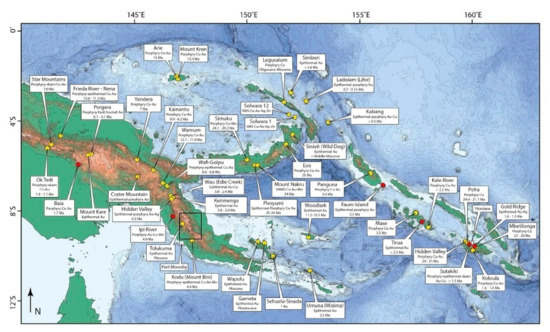
Figure 1.
Locations of known porphyry copper deposits and epithermal gold deposits (Holm et al, 2019) with the location of the study area in a dark rectangle. Red marker indicates the location of deposits and prospects where samples have been dated and discussed in Holm et. al., 2019. Yellow markers indicate locations of other known deposits.
The area of study is located along the eastern New Guinea Orogen within the East Papuan Composite Terrane (EPCT) [19,20]. The EPCT comprises ophiolite of the Papuan Ultramafic Belt (PUB) on the northeast side and metamorphic rocks of the Owen Stanley metamorphics (OSM) to the southwest (Figure 2). The two are separated by a major north-west trending fault, the Owen Stanley Fault (OSF) [21,22].
The PUB ophiolite is a Cretaceous-obducted oceanic seafloor sequence varying from a basal ultramafic zone, through a gabbroic zone to basalt in the uppermost portions [23] The ophiolite was emplaced as an upfaulted unit along the OSF against the OSM. It is intruded by Late Paleocene tonalitic stocks and overlain by Middle Eocene arc-type volcanics which rapidly deposited volcanoclastic rocks and some limestone [21].
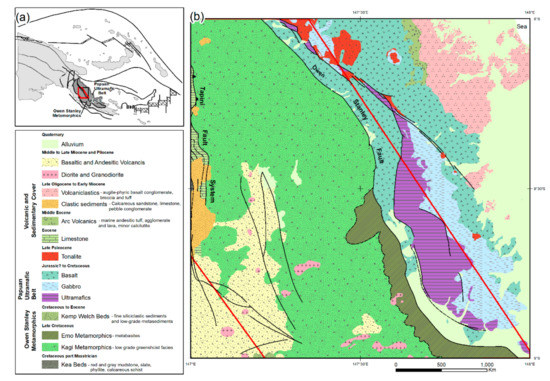
Figure 2.
Location and simplified geological maps of the area of interest: (a) location of area of interest with respect to the EPCT geological terrane and surrounding terranes of Papua New Guinea. Modified from Williamson and Hancock (2005); (b) simplified geological map of the area of interest displaying dominant rock units and faults in the area. Modified from Davies and Williamson (2012). Red polygon shows approximate extent of the airborne geophysics data for Figure 3 and Figure 4.
The OSM consists of several different units at various grades of metamorphism [13]. The metamorphic rocks in the area include low-grade greenschist facies pelitic and psammitic derived metasediments with minor metavolcanics (Kagi metamorphics), which grades into fine siliciclastic sediments and low-grade metasediments (Kemp Welch Beds) to the south and is structurally overlain by higher-grade blueschist–greenschist metabasites derived from basalt, dolerite, gabbro, and volcanic sediment (Emo metamorphics) that dips north and northeast beneath the ophiolite [13,24,25]. The protolith of the Owen Stanley metamorphics was deposited as a thick pile of fine-grained marine sediments on the rifted margin of a Paleozoic craton in the Late Cretaceous [22,25] and was metamorphosed as a result of the emplacement of the ophiolite [25,26].
The metamorphics are flanked in the west by late Cretaceous (part Maastrichtian) weakly metamorphosed calcareous sediments (Kea Beds) and an Eocene limestone unit (Mafalu Beds). These units are, in turn, unconformably overlain by Oligocene–Miocene calcareous clastic sediments. The weakly metamorphosed sediments occur as a fault slice within a set of sub-parallel N–S faults (Tapini Fault System) that also cause displacements within the Eocene sediments [25].
Geological mapping conducted by the Mineral Resources Authority (MRA) helped improve the geological resolution of the study area. The 1:100,000 map sheet is shown in Figure 2. Igneous activity in the Miocene and throughout the Pliocene resulted in the intrusion of dioritic and granodioritic stocks and the extrusion of basaltic and andesitic volcanic rocks that unconformably overlie the older rock units to the southwest. The igneous units here are closely associated with the Tolukuma gold mine and several other metal mineral prospects in the area [27].
4. Results
4.1. Geophysics
The application of magnetic and radiometric data has, over the past few years, become a useful tool in defining lithology, metal zones, and structure of porphyry copper systems [28], and even in characterising geology [29,30]. Together with the increasing application of other geospatial tools and mineral prospectivity maps [31], magnetic and radiometric datasets have become standard tools used in targeted exploration processes. The application of magnetic data has its rationale in that ore-forming magmatic fluids are rich in iron, and the amount of magnetite they deposit is dependent on the different phases the fluids undergo as they ascend into the upper crust [32]. When the magmatic fluids are flushed into the crust through deep-seated fracture systems, they form magnetic features that are highly anomalous with respect to their weakly magnetic host rocks [33]. The magnetic distinction between the intrusive body and the host rock is fundamental to the application of magnetic methods in mineral exploration. Oftentimes, intrusive bodies appear as magnetic dipoles [34]. However, when an intrusive body has undergone intense hydrothermal alteration, it may manifest as a low magnetic feature, due to the destruction of magnetite [35]. There are some deposits, for example, the Porgera intrusive complex in Papua New Guinea, that remain relatively unaltered and manifest as strongly magnetic [36].
In 2005, a large airborne geophysical survey was conducted along the central highlands of Papua New Guinea. The airborne survey acquired both magnetic and radiometric datasets at a height of 100 m above nominal terrain clearance, with the flight lines being spaced approximately 500 m apart [37]. The survey was completed in two parts—Part A, covering the Central Highlands, and Part B, covering the Eastern Papuan Peninsula. This study area falls within Part B of the airborne survey. Magnetic and radiometric data were extracted from the Part B dataset to accommodate the study area. The magnetic data were gridded to produce a total magnetic intensity map, from which a reduced to the equator image and an analytical signal image were produced for the area. The total magnetic intensity reduced to the equator response is shown in Figure 3.
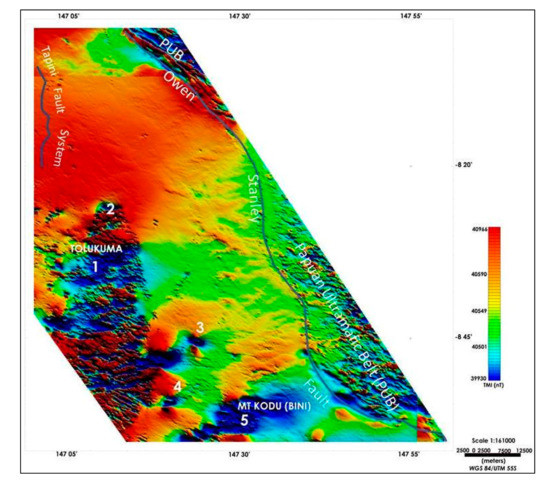
Figure 3.
Total magnetic intensity reduced to the equator image of the study area. Magnetic anomalies of interest are numbered (1–5) and are referred to in the proceeding discussions.
The magnetic image reveals a highly textured signature on the eastern side of the image. This coincides with the PUB. The western portion reveals magnetic patterns that portray sequences of volcanic activity. Prominent is a magnetically deficient signature, correlated with the Mt. Cameroon volcanics, which is surrounded by several dipolar signatures that may well represent the late Miocene and Pliocene diorites and granodiorites (Figure 3; intrusive bodies number 1−4), especially towards the southern portion of the image. To the south, a large elongated low magnetic signature trends northeast towards the PUB (Figure 3 and Figure 5), representative of late Miocene and Pliocene granodiorites mapped in the area (Figure 2). The low reduction-to-the-equator magnetic response is typical of highly magnetic plutons which are associated with volcanic activity [38]. The central part of the image is magnetically quiet, indicative of the deeper basement rocks of the area, the Kagi metamorphics [39]. Very few magnetic disturbances are visible in this area.
From the same dataset, radiometric channels potassium (K), thorium (Th), and uranium (U) count were processed, and a ternary image (RGB) was produced to show the radiometric response of the area. The ternary image is shown in Figure 4.
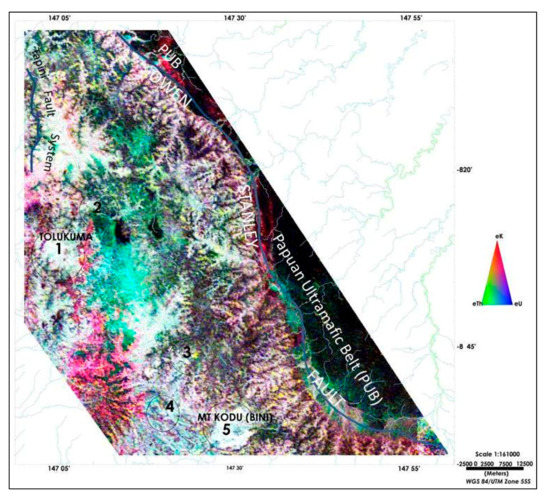
Figure 4.
Ternary radiometric image (RGB) produced from combining potassium, thorium, and uranium channels of the airborne radiometric dataset. Circular polygons indicate areas of interest. Numbers 1–5 correspond to magnetic anomalies identied in Figure 3. Anomalies 1–5 have similar radiometric response.
The ternary radiometric signature of the study area displays several characteristics. The outline of the PUB is clearly visible as the dark northwest-trending unit on the right side of Figure 3. Two other dark signatures that likely correlate with mafic or ultramafic units are visible in the central part of the image, to the east of the Tolukuma gold mine. Thorium-rich units are visible on the northern and central-western parts of the image, while the southwestern part is dominated by potassium-rich alteration of the Mt. Cameroon volcanics. White signatures indicative of high U–Th–K counts are visible in several locations including the southern part of the map sheet, around Tolukuma, and north of Tolukuma. A couple of these white spots also coincident with magnetic signatures 1 and 5. Target 1 coincides with the Tolukuma gold deposit. Target 5 is the lesser-known Mt. Kodu (Bini) porphyry deposit [40].
4.2. Geochemistry
Geochemical datasets, particularly, stream sediment datasets, have been used successfully in identifying undiscovered mineral deposits [41,42] in other jurisdictions. Specifically, the presence of elevated gold occurrences within the periphery of porphyry copper systems has been successfully used as a guide to the location of porphyry copper systems [43,44].
In Papua New Guinea, digitisation of geochemical data was commenced in the early part of 2005. This saw the beginning of historical exploration data being converted from analogue to digital spatial data for easy storage, access, and processing. To date, over 120,000 data points have been digitised, from which 11,806 data points are from stream-sediment samples. There are 9,488 stream sediment samples analysed from within the study area. To put it simply, stream sediment data is used in exploration with the notion that it is made up of mineral elements weathered and eroded from a source rock region upstream from a sampling point [45].
To observe the distribution of the mineral elements analysed from the stream sediment data, we gridded the Cu and Au channels of the stream sediment data. These are shown in Figure 5 for copper (Cu), and Figure 6 for gold (Au).
Figure 5 suggests that copper anomalism within the study area is quite widespread. The entire western portion of the study area and the northeastern parts are heavily documented with copper anomalism in the streams. The only exception is the area near the mid-eastern section where widespread copper signatures have failed to show up in stream sediment analysis data.
Figure 6 shows a gridded image of the level of gold anomalism in stream sediments distributed throughout the study area. The image depicts a high occurrence of gold anomalism, mostly distributed along the northeastern and southeastern parts of the study area. Gold anomalism also covers the area that is reported to have negligible copper occurrences in samples from the southeast of the study area.
To see how copper mineralisation is distributed with respect to gold, areas of anomalous copper in Figure 5 are shown in Figure 6. The figure shows that the upper eastern part of the Owen Stanley Fault (OSF) has occurrences of both anomalous copper and gold. In comparison, in the western part of the study area, there are multiple regions with copper anomalism but lack anomalous gold occurrences. However, there are also some western areas where there is coincident copper anomalism and gold anomalism; this helps with the identification of prospective targets for porphyry systems within the study area.
4.3. Multi-Element Geochemical Analysis—Principal Component Analysis and Pathfinders
In order to further help with the identification of porphyry mineral systems and other mineralisation signatures, we applied a principal component analysis (PCA) to a multivariate geochemical data set from the Tolukuma Mine area. This provides a case study to illustrate the benefits of integrating geochemical datasets and pathfinder elements into exploration and prospectivity studies.
The geochemical data used consisted of 118 rock chips, 206 soil samples, and 69 trench samples. The rock chip dataset consisted of geochemical results for 14 elements: Ag, As, Au, Be, Cd, Cu, Fe, Mg, Mn, Pb, Sb, Se, Sn, and Zn. Principal component 1 (PC1) yielded element associations comprising Au−Ag−Sb−As (positive loading) and Fe−Be−Zn−Mg−Sn−Mn−Cu (negative loading). The corresponding geochemical dataset derived from trench sampling comprised 13 elements: Ag, As, Au, Be, Cd, Cu, Fe, Mg, Mn, Pb, Sb, Sn, and Zn. PC1 provided elemental associations of As−Sb−Au−Ag (positive loading) similar to the rock chips, and Zn−Mg−Fe−Cu−Mn−Be−Cd (negative loading). The soil sample dataset of 11 elements contained: As, Au, Be, Cr, Cu, Co, Mg, Mo, Ni, Pb, and Zn. PC1 yielded an element association of Mo−Pb−Cu (positive loading), while PC2 provided an association between As and Au (positive loading).
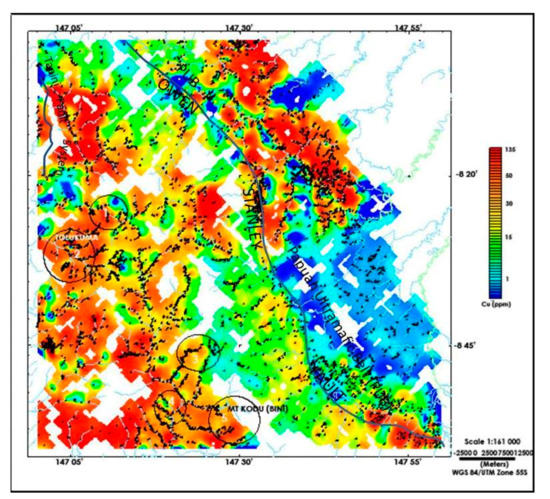
Figure 5.
Distribution of copper in stream sediment data from the study area. The locations of sampling points are shown on the map as black dots. Numbers 1–5 in the figure indicate magnetic anomalies shown in Figure 3.
The principal component analysis of the Tolukuma geochemical datasets defines two contrasting element associations that are commonly attributed to defined mineral systems; a Au−Ag−As−Sb association in the central and northwest Tolukuma area (Figure 7) is characteristic of an epithermal gold system [46], while a diverse Cu−Zn−Fe−Mg−Mn−Be ± Pb−Cd−Sn−Mo element association in the south of the Tolukuma area, which is more typical of a skarn-related mineral system [47]. While these element associations are not directly attributable to porphyry copper mineralisation, both epithermal and skarn-type deposits form an integral part of the porphyry mineral systems model [48] and may point to the potential for a blind porphyry copper system.
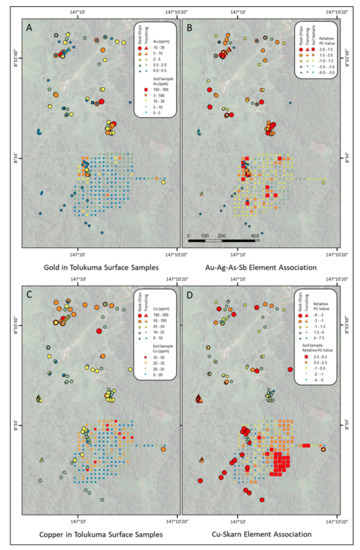
Figure 7.
Tolukuma surface geochemistry and principal component analysis from trench sampling, rock chip sampling, and soil sampling: (A) gold in surface sampling; (B) Au−Ag−As−Sb element association from principal component analysis; (C) copper in surface sampling; (D) potential Cu–skarn element association; see text for discussion.
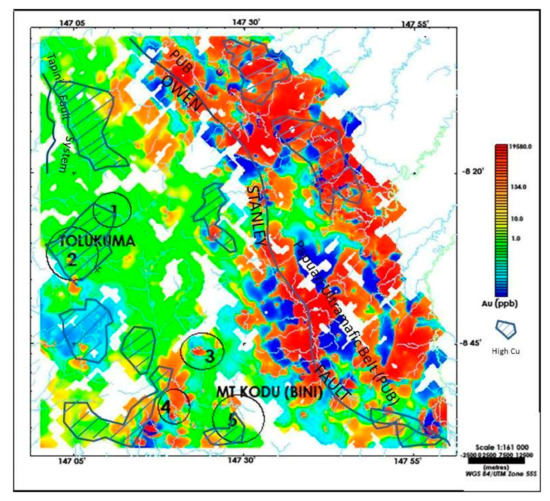
Figure 6.
Distribution of gold in the stream sediments within the study area. Hatched polygons indicate areas of high Cu occurrences. Numbers 1–5 indicate magnetic anomalies shown in Figure 3.
5. Discussion
In Papua New Guinea, the search for porphyry copper targets has now become more urgent given that almost all of the known discoveries to date have now been developed, are in the process of being commissioned for development, or are being progressed to feasibility study stages for development in the not-too-distant future. This has led to renewed interest in the application of an integrated approach in the identification of possible porphyry system targets.
Here, we combined geology, geochemistry, and geophysics to identify possible porphyry system target(s) within the study area. This approach has been previously undertaken in the past as a multi-criteria decision making (MDM) tool in mineral potential mapping [49,50]. The objective of this approach is to improve the confidence in mineral prospect identification. In this case, we combined multiple datasets to illustrate targets which we believe have a higher degree of being prospective as porphyry copper targets.
The study area shows that the distribution of copper anomalism in stream sediment samples is very highly dispersed, with copper minerals being detected in almost all parts of the study area, except the mid-section of the area over the PUB (Figure 4). The lack of occurrence of copper anomalism in this area is fascinating, but we suspect that this phenomenon may be due to the heavy leaching of copper from the area by the surrounding streams. Geological structures may also play a role in this although there have not been any major northeast-trending structures mapped in this area. However, a topographic depression may be seen which trends northeast (Figure 8) and appears to form the northern boundary of the anomalous copper distribution. We hypothesise that this depression may have been a geological structure that pre-existed the growth of the Owen Stanley Range.
The distribution of anomalous gold occurrences is most pervasive in the eastern part of the study area (Figure 6). This area has a long history of alluvial gold mining along the streams and river systems that dates back to the early 1900s. Some of the goldfields include Yodda, Gira, Doriri, Gona, and Kereri, which have also been mined for their platinum group elements (PGEs) and other alloys [51,52,53,54]. The major intrusive rock type mapped around these areas is tonalite, (Figure 2), which has previously been attributed as the source of the gold in this area [55] and may have been emplaced at the same time as the Eocene tonalite, quartz diorite, and porphyry system that is interpreted to have been responsible for the Waria River alluvial goldfields further northwest [54]. These gold occurrences are interpreted to have been deposited in an epithermal environment in magmatic arc systems [56]. The occurrence of PGE metals between the Waria goldfields and this part of the country [54] may also indicate metal deposition in low-temperature environments [57].
West of the Owen Stanley Range (Figure 6), the occurrence of gold anomalism in stream sediments appears to be restricted only to the southern part of the study area (around Targets 3−5), with some occurrences reported within the vicinity of the Tolukuma gold mine. Stream sediment analysis of gold from the area, however, indicates that the area is still quite prospective with gold anomalies greater than 100 ppb and associated with the occurrence of Ag, As and Sb metals.
The comparatively lower occurrence of gold in stream sediments samples from around the Tolukuma area compared to the eastern part of the Owen Stanley Range does not necessarily mean that the probability of locating a gold-bearing mineral deposit in this area is low. Rather, gold-bearing deposits in this area were emplaced as veins, dykes, and stocks that may represent high-grade, small-tonnage systems with a low transported sediment expression, or alternatively, the gold systems may be buried under the thick volcanic cover. The Tolukuma gold mine is one of the PNG’s medium-scale underground high-grade gold deposits (0.3 Mt @ 29.9 g/t Au; [1]) and is an example of a mineral system that only has little surface exposure to weathering and erosion. This view is supported by the integration of geochemical datasets with element associations characteristic of epithermal Au and Cu–skarn-related mineral systems, which may be indicative of a blind porphyry copper system at depth.
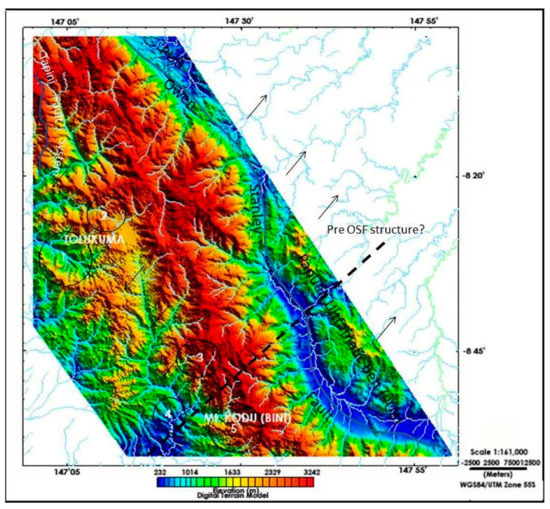
Figure 8.
NE–SW trending structure (in heavy dashed line) responsible for the emplacement of the Mt. Kodu (Bini) porphyry. The structure, which may also be responsible for restricting anomalous gold occurrences only to the upper part of the PUB (Figure 5), is intersected by the Owen Stanley Fault (OSF). Smaller arrows indicate regional stream drainage direction. Numbers 1–5 indicate the locations of magnetic anomalies identified in Figure 3.
The magnetic signature of the study area depicts several areas which may be of interest as intrusive bodies. These are identified as small dipolar bodies surrounding a larger magnetic expression. By comparing these magnetic anomalies with the occurrences of copper and gold, we find that the three southern anomalies show associated high occurrences of anomalous gold and copper. This is in contrast to the northern magnetic anomalies, which only show associated elevated copper occurrences and not gold. Tolukuma, an underground gold mine, is located in the vicinity of one of these interpreted intrusive bodies.
The magnetic signatures were also correlated with the ternary radiometric image. Correlation shows that magnetic anomalies marked 2, 3, and 4 do not show radiometric patterns that are often attributed to porphyry systems (Figure 3 and Figure 4). They have low potassic, thorium, and uranium responses. This would suggest a buried intrusive unit undetectable or only with a small surface expression for its radiometric signal, or alternatively, a relatively mafic or low-potassium felsic system that has not undergone hydrothermal alteration. Only anomalies 1 (Tolukuma) and 5 (Mt. Kodu) display radiometric attributes that are often attributed to porphyry intrusions, especially granitic suites [7]; they display enhanced counts in all three radiometric channels. The combined effect of three radiometric channels (K, Th, and U) in the ternary imaging process produces a lighter signature, as displayed by anomalies 1 and 5, compared to areas with low counts in the three radiometric elements
The magnetic anomaly marked 5 (Kodu Prospect; Figure 3) is an elongated body that resembles an intrusive body that has been emplaced into a northeast-trending structure. The intrusive body has a radiometric signature similar to the Tolukuma radiometric signature. Geologically, not much of this body is visible; most of it is likely buried under the thick volcanic sequence but is interpreted through the magnetic response and the shallower part of this intrusion is visible through the radiometric response.
Geochemical sampling [40] has revealed associated high copper (>500 ppm) and gold counts (>30 ppm) in stream sediment samples collected from the study area. Geochemical sampling does not cover the entire extent of the magnetic anomaly and was also limited in the analysis of appropriate pathfinder elements (e.g., Cu, Pb, Zn, Ag, and Mo). However, in the first instance, the high copper and gold levels, supported by element associations derived from the principal component analysis that are typical of mineralisation, provide a good indication of the prospectivity for porphyry copper systems. These datasets need to be followed up with further sampling and analysis for a robust suite of elements for effective geochemical exploration.
6. Conclusions
The combination of geochemical, geophysical, and geological datasets for the Papuan Peninsula region has demonstrated, with some success, the potential to constrain the extent of exploration to areas that have a higher chance of hosting mineralisation. It has also exemplified the difficulties in solely relying on limited datasets as the basis for identifying potential porphyry targets. This exercise has demonstrated the following:
- Not all areas that have high gold anomalism will also have high copper occurrences;
- Not all magnetic anomalies will have associated high gold and copper anomalism in proximal stream sediment data;
- Not all magnetic anomalies will have porphyry-style radiometric responses;
- Not all areas with porphyry-style radiometric signatures will show high gold and copper occurrences in proximal stream sediment datasets;
- Different datasets have their own strength and weaknesses.
This implies that an integrated approach to mineral exploration is highly recommended in identifying the next big porphyry copper deposit, and it is always good to have more than two different datasets to derisk a prospect. As has been exemplified here, not all intrusive bodies have associated gold and copper occurrences. It is, therefore, better to consider all datasets together to see how they correlate with each other before deciding on the target for further exploration methods, such as drilling. In this exercise, we have shown that there are magnetic bodies which are likely associated with intrusions that display enhanced radiometric signatures, as well as associated high gold and copper anomalism. Such areas are recommended for further exploration programmes.
Author Contributions
Conceptualisation, N.M.; Methodology N.M. and A.B.; Gridding software, N.M. Standard edition, Formal analysis, N.M., A.B. and R.H., Original draft preparation, N.M. and A.B, Writing review and editing R.H. and M.P. All authors have read and agreed to the published version of the manuscript.
Funding
This research received no external funding.
Data Availability Statement
Data supporting this research paper may be obtained with permission from the Mineral Resources Authority, Email info@mra.gov.pg.
Conflicts of Interest
The authors declare no conflict of interest.
References
- Holm, R.J.; Tapster, S.; Jelsma, H.A.; Rosenbaum, G.; Mark, D.F. Tectonic evolution and copper-gold metallogenesis of the Papua New Guinea and Solomon Islands region. Ore Geol. Rev. 2019, 104, 208–226. [Google Scholar] [CrossRef] [Green Version]
- Tapster, S.; Condon, D.; Naden, J.; Noble, S.; Petterson, M.; Roberts, N.; Saunders, A.; Smith, D.; Tapster, S.; Condon, D.; et al. Rapid thermal rejuvenation of high-crystallinity magma linked to porphyry copper deposit formation; evidence from the Koloula Porphyry Prospect, Solomon Islands. Earth Planet. Sci. Lett. 2016, 442, 206–217. [Google Scholar] [CrossRef] [Green Version]
- Page, R.W.; McDougall, I. Ages of Mineralization of Gold and Porphyry Copper Deposits in the New Guinea Highlands. Econ. Geol. 1972, 67, 1034–1048. [Google Scholar] [CrossRef]
- Mason, D.R.; McDonald, J.A. Intrusive rocks and porphyry copper occurrences of the Papua New Guinea-Solomon Islands region; a reconnaissance study. Econ. Geol. 1978, 73, 857–877. [Google Scholar] [CrossRef]
- Richards, J.P.; Ledlie, I. Alkalic intrusive rocks associated with the Mount Kare gold deposit, Papua New Guinea; comparison with the Porgera intrusive complex. Econ. Geol. 1993, 88, 755–781. [Google Scholar] [CrossRef]
- Fengming, X.; Xiang, X. High-Potassium Calc-Alkaline Intrusive Rocks in Tongling Area, Anhui Province. Geochimica 1996, 1, 1–24. [Google Scholar]
- Kumwenda, J.; Lackie, M. Geophysical interpretation of the geology of the Stanthorpe region using aeromagnetic, gravity and radiometric data. Explor. Geophys. 2019, 50, 653–666. [Google Scholar] [CrossRef]
- Halvaksz, J. Cannibalistic Imaginaries: Mining the Natural and Social Body in Papua New Guinea. Contemp. Pac. 2006, 18, 335–359. [Google Scholar] [CrossRef] [Green Version]
- Nelson, H. Black, White and Gold. Goldmining in Papua New Guinea 1878–1930; ANU Press: Canberra, Australia, 2016. [Google Scholar]
- Hancock, G. Mining in Papua New Guinea, No Colours... Gone Fishing! Pacific Islands Applied Geoscience Commission (SOPAC): Suva, Fiji, 2009; Volume 11, p. 17. [Google Scholar]
- Clark, J. Gold, sex, and pollution: Male illness and myth at Mt. Kare Papua New Guinea. Am. Ethnol. 1993, 20, 742–757. [Google Scholar]
- Noller, B.; Saulep, G. Evaluation of cleanup following loss of cyanide in flight to Tolukuma (Papua New Guinea) gold mine. Eur. J. Miner. Process. Environ. Prot. 2004, 4, 49–61. [Google Scholar]
- Davies, H.L. The geology of New Guinea—the cordilleran margin of the Australian continent. Episodes 2012, 35, 87–102. [Google Scholar] [CrossRef] [PubMed]
- Howe, B.; Kroll, A. The Geophysical Response of the Tupinda Cu-Au-Mo Porphyry Prospect, Tabar Islands, Papua New Guinea. ASEG Ext. Abstr. 2010, 2010, 1–5. [Google Scholar] [CrossRef] [Green Version]
- Holm, R.; Spandler, C.; Richards, S.W. Continental collision, orogenesis and arc magmatism of the Miocene Maramuni arc, Papua New Guinea. Gondwana Res. 2015, 28, 1117–1136. [Google Scholar] [CrossRef]
- Pigram, C.; Symonds, P. A review of the timing of the major tectonic events in the New Guinea Orogen. J. Asian Earth Sci. 1991, 6, 307–318. [Google Scholar] [CrossRef]
- Davies, H.; Perembo, R.C.B.; Winn, R.D.; KenGemer, P. Terranes of the New Guinea orogen. In Proceedings of the Geology Exploration and Mining Conference, Madang, Papua New Guinea, 1 January 1997; Australasian Institute of Mining and Metallurgy: Melbourne, Australia, 1997. [Google Scholar]
- Lindley, I.D. Extensional and Vertical Tectonics in the New Guinea Islands: Implications for Island Arc Evolution; Lavecchia, G., Scalera, G., Eds.; Annals of geophysics; INSPEC: Sgonico, Italy, 2006; pp. 403–426. [Google Scholar]
- Davies, H.; Winn, R.; KenGemar, P. Evolution of the Papuan Basin-A View from the Orogen. In Proceedings of the Petroleum Convention Proceedings, Port Moresby, Papua New Guinea, 9–11 September 1996. [Google Scholar]
- Kalkman, V.J.; Dijkstra, K.-D.B.; Dow, R.A.; Stokvis, F.R.; van Tol, J. Out of Australia: The Argiolestidae reveal the Melanesian Arc System and East Papua Composite Terrane as possible ancient dispersal routes to the Indo-Australian Archipelago (Odonata: Argiolestidae). Int. J. Odonatol. 2018, 21, 1–14. [Google Scholar] [CrossRef]
- Davies, H.L. New Guinea, Geology. In Encyclopedia of Islands; University of California Press: San Fransisco, CA, USA, 2019; pp. 659–665. [Google Scholar]
- Sheppard, S.; Cranfield, L. Geological Framework and Mineralization of Papua New Guinea—An Update; Mineral Resources Authority: Port Moresby, Papua New Guinea, 2012; p. 65. [Google Scholar]
- Williamson, A.; Hancock, G. The Geology and Mineral Potential of Papua New Guinea; Papua New Guinea Department of Mining: Port Moresby, Papua New Guinea, 2005; p. 152. [Google Scholar]
- Pieters, P. Port Moresby-Kalo-Aroa-1:250,000 Geological Series; Explanatory Notes to Accompany Port Moresby-Kalo-Aroa; Geological Survey of Papua New Guinea: Port Moresby, Papua New Guinea, 1978; Volume 250, pp. 55–56.
- Davies, H.; Williamson, A. Buna, Papua New Guinea, 1:250,000 Geological Series; Geological Survey of Papua New Guinea Explanatory Notes SC/55–3; Geological Survey of Papua New Guinea: Port Moresby, Papua New Guinea, 1998.
- Dow, D.B. A Geological Synthesis of Papua New Guinea; Inist-CNRS: Vandœuvre-lès-Nancy, France, 1977. [Google Scholar]
- Corbett, G. Epithermal Au-Ag deposit types–implications for exploration. In Proceedings of the Proexplo Conference, Lima, Peru, 15 May 2005. [Google Scholar]
- Clark, D.A. Magnetic effects of hydrothermal alteration in porphyry copper and iron-oxide copper–gold systems: A review. Tectonophysics 2014, 624–625, 46–65. [Google Scholar] [CrossRef]
- Boyd, D.; Isles, D. Geological Interpretation of Airborne Magnetic Surveys–40 Years On. In Proceedings of the Exploration 07: Fifth Decennial International Conference on Mineral Exploration, Toronto, ON, Canda, 9–12 September 2007. [Google Scholar]
- Isles, D.; Rankin, L. E-book on geological interpretation of aeromagnetic data now free! Preview 2019, 2019, 17. [Google Scholar] [CrossRef] [Green Version]
- Yazdi, Z.; Rad, A.R.J.; Ajayebi, K.S. Analysis and modeling of geospatial datasets for porphyry copper prospectivity mapping in Chahargonbad area, Central Iran. Arab. J. Geosci. 2015, 8, 8237–8248. [Google Scholar] [CrossRef]
- Clark, D.A. Magnetic petrology of igneous intrusions: Implications for exploration and magnetic interpretation. Explor. Geophys. 1999, 30, 5–26. [Google Scholar] [CrossRef]
- Hildenbrand, T.G. Regional Crustal Structures and Their Relationship to the Distribution of Ore Deposits in the Western United States, Based on Magnetic and Gravity Data. Econ. Geol. 2000, 95, 1583–1603. [Google Scholar] [CrossRef]
- Yáñez, G.A.; Ranero, C.R.; Von Huene, R.; Díaz, J. Magnetic anomaly interpretation across the southern central Andes (32°–34° S): The role of the Juan Fernández Ridge in the late Tertiary evolution of the margin. J. Geophys. Res. Space Phys. 2001, 106, 6325–6345. [Google Scholar] [CrossRef]
- Riveros, K.; E Veloso, E.; Campos, E.C.; Menzies, A.; Veliz, W. Magnetic properties related to hydrothermal alteration processes at the Escondida porphyry copper deposit, northern Chile. Miner. Deposita 2014, 49, 693–707. [Google Scholar] [CrossRef]
- Schmidt, W.P.; Clark, D.A.; Logan, K.J. Palaeomagnetism, magnetic petrophysics and magnetic signature of the Porgera intrusive complex, Papua New Guinea. Explor. Geophys. 1997, 28, 276–280. [Google Scholar] [CrossRef]
- Mosusu, N.; McKenna, K.; Saroa, D. Identifying potential mineralisation targets through airborne geophysics—The Western Papua New Guinea Case study. ASEG Ext. Abstr. 2016, 2016, 1–5. [Google Scholar] [CrossRef] [Green Version]
- Kon, S.; Nakamura, N.; Funaki, M.; Sakanaka, S. High magnetic susceptibility granodiorite as a source of surface magnetic anomalies in the King George Island, Antarctica. In Proceedings of the AGU Fall Meeting, San Francisco, CA, USA, 3−7 December 2012. [Google Scholar]
- Lus, W.Y.; McDougall, I.; Davies, H.L. Age of the metamorphic sole of the Papuan Ultramafic Belt ophiolite, Papua New Guinea. Tectonophysics 2004, 392, 85–101. [Google Scholar] [CrossRef]
- Dugmore, M.; Leaman, P.; Philip, R. Discovery of the Mt Bini porphyry copper-gold-molybdenum deposit in the Owen Stanley Ranges, Papua New Guinea—A geochemical case history. J. Geochem. Explor. 1996, 57, 89–100. [Google Scholar] [CrossRef]
- Cheng, Q. Mapping singularities with stream sediment geochemical data for prediction of undiscovered mineral deposits in Gejiu, Yunnan Province, China. Ore Geol. Rev. 2007, 32, 314–324. [Google Scholar] [CrossRef]
- Zuo, R.; Cheng, Q.; Agterberg, F.; Xia, Q. Application of singularity mapping technique to identify local anomalies using stream sediment geochemical data, a case study from Gangdese, Tibet, western China. J. Geochem. Explor. 2009, 101, 225–235. [Google Scholar] [CrossRef]
- Jones, B.K. Application of metal zoning to gold exploration in porphyry copper systems. J. Geochem. Explor. 1992, 43, 127–155. [Google Scholar] [CrossRef]
- Albino, G.V. Application of metal zoning to gold exploration in porphyry copper systems, by B.K. Jones: Comments. J. Geochem. Explor. 1993, 48, 359–365. [Google Scholar]
- Fletcher, W. Stream sediment geochemistry in today’s exploration world. In Proceedings of the Exploration 07: Fifth Decennial International Conference on Mineral Exploration, Toronto, ON, Canada, 14–18 September 1997. [Google Scholar]
- Taylor, B.E. Epithermal Gold Deposits. Mineral Deposits Of Canada: A Synthesis Of Major Deposit-Types, District Metallogeny, The Evolution Of Geological Provinces, and Exploration Methods; Geological Association of Canada, Mineral Deposits Division, Special Publication: Otawa, ON, Canada, 2007; Volume 5, pp. 113–139. [Google Scholar]
- Chang, Z.; Shu, Q.; Meinert, L. Skarn Deposits of China. In Mineral Deposits of China; Zhaoshan, C., Goldfard Richard, J., Eds.; Special Publications of the Society of Economic Geologists, 22; Society of Economic Geologists: Littleton, CO, USA, 2019; pp. 189–234. [Google Scholar]
- Sillitoe, R.H. Porphyry Copper Systems. Econ. Geol. 2010, 105, 3–41. [Google Scholar] [CrossRef] [Green Version]
- Abedi, M.; Norouzi, G.-H. A general framework of TOPSIS method for integration of airborne geophysics, satellite imagery, geochemical and geological data. Int. J. Appl. Earth Obs. Geoinf. 2016, 46, 31–44. [Google Scholar] [CrossRef]
- Bonham-Carter, G.F.; Agterberg, F.P.; Wright, D.F. Integration of geological datasets for gold exploration in Nova Scotia. Digit. Geol. Geogr. Inf. Syst. 1989, 10, 15–23. [Google Scholar]
- Weiser, W.T.; Bachmann, H.G. Platinum-group minerals from the Aikora river area, Papua New Guinea. Can. Mineral. 1999, 37, 1131–1145. [Google Scholar]
- Harris, C.D.; Cabri, L.J. The nomenclature of the natural alloys of osmium, iridium and ruthenium based on new compositional data of alloys from world-wide occurrences. Can. Mineral. 1973, 12, 104–112. [Google Scholar]
- Lole, H. The trend in Artisanal and Small Scale Mining Development in Papua New Guinea. Learning Event, Manila, Philippines. Available online: http://www.casmite.org (accessed on 30 July 2009).
- Lindley, I.D. Epithermal and arc-related layered mafic platinum-group element mineralisation in the mafic–ultramafic rocks of eastern Papua. Aust. J. Earth Sci. 2016, 63, 393–411. [Google Scholar] [CrossRef]
- Davies, H. Notes on Papuan Ultramafic Belt Mineral Prospects, Territory of Papua and New Guinea (Record 1969/67); Bureau of Mineral Resources, Geology & Geophysics: Canberra, Australia, 1969.
- Corbett, G. Epithermal gold for explorationists. AIG News 2002, 67, 1–8. [Google Scholar]
- Holwell, D.A.; Adeyemi, Z.; Ward, L.A.; Smith, D.J.; Graham, S.D.; McDonald, I.; Smith, J. Low temperature alteration of magmatic Ni-Cu-PGE sulfides as a source for hydrothermal Ni and PGE ores: A quantitative approach using automated mineralogy. Ore Geol. Rev. 2017, 91, 718–740. [Google Scholar] [CrossRef] [Green Version]
Publisher’s Note: MDPI stays neutral with regard to jurisdictional claims in published maps and institutional affiliations. |
© 2021 by the authors. Licensee MDPI, Basel, Switzerland. This article is an open access article distributed under the terms and conditions of the Creative Commons Attribution (CC BY) license (https://creativecommons.org/licenses/by/4.0/).